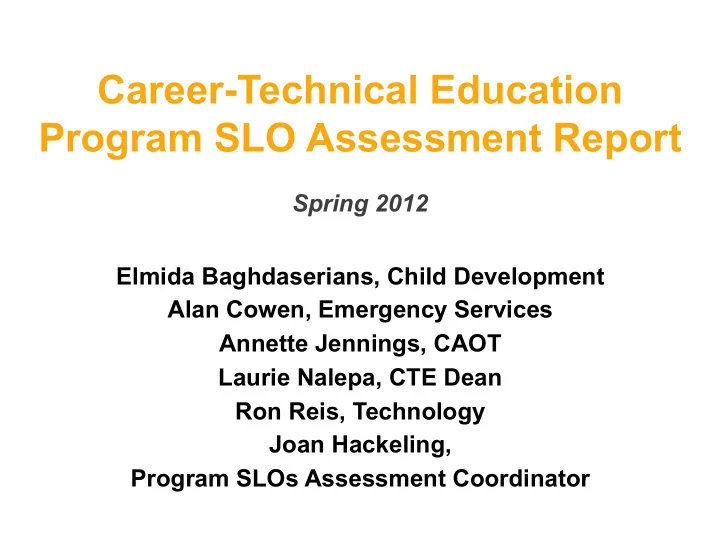

Career-Technical Education Program SLO Assessment Report Spring 2012 Elmida Baghdaserians, Child Development Alan Cowen, Emergency Services Annette Jennings, CAOT Laurie Nalepa, CTE Dean Ron Reis, Technology Joan Hackeling, Program SLOs Assessment Coordinator
Institutional Assessment Model • Course Outcomes Assessment • Program Outcomes Assessment • Service Outcomes Assessment
Program SLO Assessment Model Three Program Pathways: • Foundational Skills • Career-Technical Education • General Education / Transfer Do you know the status of your program outcomes assessment?
CTE Program Outcomes: 1. Communication Skills 2. Reasoning / Critical Thinking Skills 3. Technical Skills 4. Professional Behavior
Evidence of Program Outcomes: • Writing samples • Reasoning samples • Faculty evaluations of professional behavior • Results of professional licensing exams • Survey of CTE student completers • Advisory Board surveys • Employer surveys
Major Findings: 1. Majority of students met learning outcomes * 2. Areas for improvement: • Writing : organization, grammar, sentence structure • Reasoning: more complex reasoning skills • Professional behavior: responsibility, punctuality
Major Recommendations: Impact Resources
Major Recommendations: 1) Share expectations Make them visible Make them explicit • All CTE Students & Faculty • Advisory Boards & Employers • Administrators & Staff
2) Create more opportunities for students to practice program-level skills.
3) Integrate program learning outcomes assessment rubrics into coursework. Have students evaluate their own work. Washington State U. Critical Thinking Project: • Integrating assessment rubrics into courses improved critical thinking dramatically. • Participating faculty supported unanimously.
4) Support faculty in making adjustments • Develop guiding materials • Create virtual conversations • Direct students to campus learning resources
LAVC Program Assessment: Career Technical Education Pathway SLO COMMITTEE PLANNING, REPORTING, APPROVAL STEP 7: Implement Plan to Implement changes to improve student learning Improve Student Learning STEP 6: Report out findings to appropriate bodies Report out findings STEP 5: Review findings collaboratively; Review Findings, develop plan to improve student learning Plan for Improvement STEP 4: Analyze Apply rubrics to assess student Analyze survey results Assess Program exam results work and professional behavior Data STEP 3: Collect Sample Conduct surveys Collect Program Data exam results student work STEP 2: Identify Create surveys Prep for Program Data Complete Develop rubrics professional for students, employers alignment grids Sampling & Collection & advisory boards exams STEP 1: Plan Program Plan LAVC Program Assessment Model Assessment Process Program assessment at Los Angeles Valley College is a faculty-owned process. It is guided by the College ’ s SLO Committee, facilitated by the College ’ s Office of Research & Planning, and coordinated by the College ’ s Program Assessment Coordinator.
Recommend
More recommend